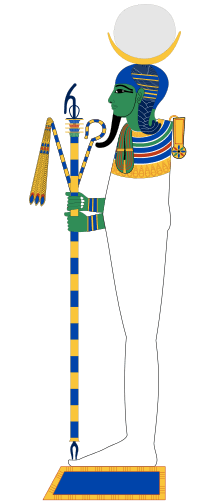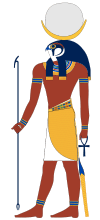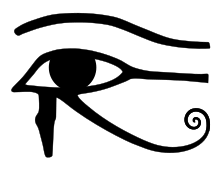Khonsu
Khonsu (Ancient Egyptian: ḫnsw; also transliterated Chonsu, Khensu, Khons, Chons or Khonshu) is the ancient Egyptian god of the Moon. His name means "traveller", and this may relate to the perceived nightly travel of the Moon across the sky. Along with Thoth he marked the passage of time. Khonsu was instrumental in the creation of new life in all living creatures. At Thebes he formed part of a family triad (the "Theban Triad") with Mut as his mother and Amun his father.
| Khonsu | |||||
|---|---|---|---|---|---|
 Khonsu in human form | |||||
| Name in hieroglyphs | |||||
| Major cult center | Thebes | ||||
| Symbol | the moon disk, the sidelock, falcon, crook and flail, was-scepter | ||||
| Parents | Amun and Mut | ||||


Mythology
| Part of a series on |
| Ancient Egyptian religion |
|---|
 |
|
Beliefs |
|
Practices
|
|
Deities (list) |
|
Locations |
|
Symbols and objects
|
|
Related religions
|
|
|
Khonsu's name reflects the fact that the Moon (referred to as Iah in Egyptian) travels across the night sky, for it means "traveller", and also had the titles "Embracer", "Pathfinder", and "Defender", as he was thought to watch over those who travel at night. As the god of light in the night, Khonsu was invoked to protect against wild animals, and aid with healing. It was said that when Khonsu caused the crescent moon to shine, women conceived, cattle became fertile, and all nostrils and every throat was filled with fresh air.
Attributes
In art, Khonsu is typically depicted as a mummy with the symbol of childhood, a sidelock of hair, as well as the menat necklace with crook and flail. He has close links to other divine children such as Horus and Shu. He is sometimes shown wearing an eagle or falcon's head like Horus, with whom he is associated as a protector and healer, adorned with the sun disk and crescent moon.[1]
Khonsu is mentioned in the Pyramid Texts and Coffin Texts, in which he is depicted in a fierce aspect, but he does not rise to prominence until the New Kingdom, when he is described as the "Greatest God of the Great Gods". Most of the construction of the temple complex at Karnak was centered on Khonsu during the Ramesside period.[1] His temple at Karnak is in a relatively good state of preservation, and on one of the walls is depicted a creation myth in which Khonsu is described as the great snake who fertilizes the Cosmic Egg in the creation of the world.[2]
Khonsu's reputation as a healer spread outside Egypt; a stele records how a princess of Bekhten was instantly cured of an illness upon the arrival of an image of Khonsu.[3] King Ptolemy IV, after he was cured of an illness, called himself "Beloved of Khonsu Who Protects His Majesty and Drives Away Evil Spirits".
In popular culture
In the Egyptian myth-based trilogy, The Kane Chronicles, Khonsu is allowed by Osiris to visit the main characters, Sadie and Carter, who need three hours to pass through the Houses of Night. He explained that, as being god of the moon, he could grant them the hours they required, but the only way he would grant them three hours is if they bet their Rens, or secret name, a word that held great power over a soul, on a game of Senet, an Ancient Egyptian board game. He would give one hour for every game piece they got off the board, but for every game piece he got off the board, he would take one Ren. After counseling from a god and friend, Bes, the main characters made a move that got their third game piece off the board, but then allowed Khonsu to get a piece off the board as well. So Khonsu took Bes's secret name, and his body, despite not being part of the agreement. He then disappeared before Carter could attack him.
In Marvel Comics, the character Moon Knight is the avatar of Khonshu, who grants him supernatural abilities to fight evil in his name, but also slowly drives him insane.
In the web serial Worm, Khonsu is the name given to one of the Endbringers, a giant monster in the series who can manipulate time.
In the novel The Claws of Time by Jason Charles, Khonsu sends the female protagonist Dimiza/River five hundred and twenty years into the future (from 1483 to 2003) to escape being executed by her lover, King Richard III, whom she helped become king.
See also
Notes
- "The Oxford Guide: Essential Guide to Egyptian Mythology", Edited by Donald B. Redford, pp. 186–187, Berkley, 2003, ISBN 0-425-19096-X
- Handbook of Egyptian Mythology, Geraldine Pinch, p156, ABC-CLIO, 2002, ISBN 1-57607-242-8
- This incident is mentioned in the opening of chapter one of Bolesław Prus' 1895 historical novel Pharaoh.